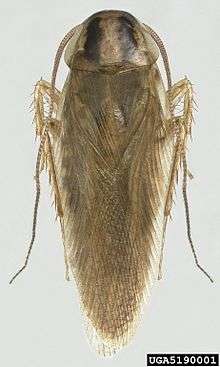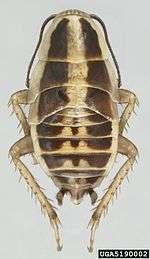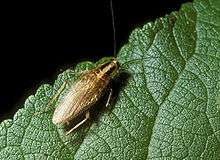Blattella asahinai
The Asian cockroach (Blattella asahinai), is a species of cockroach that was first described in 1981 from insects collected on Okinawa Island, Japan.[1] It is a small species of cockroach, and typically are 1.3 to 1.6 cm long and is tan to dark brown in colour with dark parallel stripes on the back of their head.[2] It is commonly mistaken with the German cockroach (Blattella germenica) for their similar appearance. It is commonly found in the United States in and around houses.
| Asian cockroach | |
|---|---|
 | |
| Asian cockroach: adult specimen | |
| Scientific classification | |
| Kingdom: | Animalia |
| Phylum: | Arthropoda |
| Class: | Insecta |
| Order: | Blattodea |
| Family: | Ectobiidae |
| Genus: | Blattella |
| Species: | B. asahinai |
| Binomial name | |
| Blattella asahinai Mizukubo, 1981 | |
Characteristics and appearance
The Asian cockroach is nearly identical to the German cockroach (Blattella germanica) except for a few minor morphological differences. Like the German cockroach, it is about 1.6 cm (0.63 in) long, is tan to brown in color, and has wings. However, its wings are longer than the German cockroach, and a difference is seen between a groove in the abdomen between the two species. The quickest way to tell the difference between the two species is that the Asian cockroach is a strong flyer (almost like a moth) and is attracted to light, unlike the German cockroach.[1] This species tends to prefer the outdoors, whereas the German cockroach prefers living indoors. The Asian and German cockroach look identical to the naked eye as they both have tan and dark features as well as two parallel stripes behind the head. The almost identical appearance has caused concerns and issues with the pest management industries when determining the strategies of pest control as pesticides for German cockroaches are not always effective for Asian cockroaches.[3] To differentiate between the two cockroaches with the naked eye, there are noticeable parts of each cockroach. The ventral surface of the left mandible, the vein coloration of the right tegmen, the wing size and venation as well as the setal marginal bristles on the cerci are the slight morphological differences between the Asian and German cockroach.[3]

History and distribution
The Asian cockroach was first cited and documented in Okinawa Island, Japan in 1981 by Dr. Takayuki Mizukubo, from the National Institute of Agro-Environmental Sciences.[4] The introduction of the exotic Asian cockroach to the United States was in 1986 in Lakeland, Florida but was first believed to be German cockroach. It was believed that the Asian cockroach came to Florida through the import of goods from Japan. On March 3, 1986, Dr Louis M. Roth received cockroaches of Lakeland, Florida from Dr Philip G. Koehler of Florida Extension Services of the University of Florida for inspection.[4] It was noted that a pest control worker referred to them as "German cockroaches" but could fly readily and were common outdoors. The only two species of Blattella present in the United States were the Field cockroach (Blattella vaga) and the German cockroach (Blattella germanica). Roth was unaware of the species Blatella asahinai but discovered it and sent several Lakeland specimens to Dr. Mizukubo and he concluded they were Blatella asahinai.
Further testing was implemented by the Center for Urban and Structural Entomology from Texas A&M University in September 2007[5] where they tested the two species through an ethological, morphological and genetic approach in order to confirm the presence of the Asian cockroach in Harris County, Texas. Evaluations of DNA gene sequence were tested which resulted in being similar to the German cockroach.[5] It was evaluated that environmental factors play a significant role in determining the two species although there are slight morphological differences. It was confirmed that Asian Cockroaches were discovered in Harris County, Texas in May 2006 around the Barker Reservoir found in both urban and undeveloped areas. These cockroaches were later cited in Hunter’s Creek subdivision in Houston. The Asian cockroach has since expanded throughout much of Florida and is spreading into other southern states. In addition to Florida, it is reported in Alabama, Georgia, South Carolina, and Texas.[1] In Dothan, Alabama in 2003, there were several reports that stated there were "flying German cockroaches" from Alabama Cooperative Extension System agents, where specimens were obtained for identification. Using a male specimen and comparing to the description of Dr. Mizukubo and Dr. Roth confirmed that the specimens were Asian cockroaches.[6]
Habitat and behaviour
Asian cockroaches are predominantly found outdoors in shaded mulched, composted areas where fresh plant litter accumulates as well as in damp areas.[7] Large areas of grass or leaf litter are what the Asian cockroach gravitates towards. When the Asian cockroach is happy with the chosen location, they are the dominant cockroach and take over the location where they tend to form hordes of 30,000 to 250,000 cockroaches per acre.[7] Its population reaches its zenith in late August and declines rapidly with the onset of cool weather.[8] Asian Cockroaches are the most active at dusk and are attracted to light-coloured surfaces and bright lights. This means at dusk, the Asian cockroach may fly towards the home and enter through open doors and windows but indoor invasions occur rarely. While in the home, the Asian cockroach is most likely found sitting on the TV screen or near lamps. While other cockroaches carry diseases and bacterium, as of today, research has not suggested that the Asian cockroach carries any pathogens or diseases. Although, they do come into contact with other bacteria due to their habitat preferences being around homes with outdoor pathogens, animal feces, and fungi.[7]
Mulch preferences
Leaf litter of all kinds is where the Asian cockroach is most commonly found. In the Southern states of America, typical mulch types include cypress, oak leaf litter, pine, rubber, and topsoil.[9] As leaf litter is used as domestic mulching for general purpose landscaping, using this type of mulch can affect how dense indoor populations of the Asian cockroach can be. They are predominantly a nocturnal species of cockroach, although they live and breed outdoors, they are attracted to light sources will find their way into buildings.[9] These can include homes, office buildings, and restaurants. The Asian cockroach stays clear of topsoil and rubber mulch and has very little interaction with cypress mulch.[9] During adverse weather conditions such as cold weather or dry conditions, the Asian cockroach burrows down into the leaf litter.[10]
Diet
The Asian cockroach is similar to most cockroach species, in that these pests are omnivores and will eat anything they can find. They have been observed to eat human food, pet food, flowers and agricultural crops. Common agricultural crops such as soybeans and cotton are where the Asian cockroaches are found feeding on prey.[11] They have also been sighted feeding on lettuce, cabbage, and strawberries.[12]
German cockroach comparison
The Asian cockroach is the closest discovered relative of the German cockroach, the predominant cockroach pest in America and some parts of the world.[13]
Behaviour
The Asian cockroach has longer but narrower wings than the German cockroach.[7] It can be observed flying, predominantly its preferred choice of movement especially when disturbed,[14] and to move around compared with the German cockroach, which can be rarely seen flying, merely fluttering its wings ineffectively.[15] The other main difference between the two species is its reaction to light sources, the Asian cockroach is naturally attracted to light compared to the German cockroach which scatters away in the presence of bright light.[16]
Reproduction and life cycle
Asian cockroaches and field cockroaches are similar ecologically in comparison to the German cockroach due to both these species breeding outdoors. Both the female Asian and German cockroach carry their egg capsules (oothecae) with them until the eggs hatch[13] but female Asian cockroaches produces fewer oothecae in comparison to the German cockroach, producing approximately four oothecae in their lifetime, each averaging 35 - 40 eggs.[7] Asian Cockroaches have longer initial and subsequent pre-oviposition periods than its German counterpart, and their eggs require slightly longer time to hatch. Asian adult females produce their first egg ootheca approximately 13 days after becoming an adult, and the period from when the ootheca first appeared to hatching is approximately 19 days. The female German cockroach can produce an Ootheca after approximately 8 days after becoming an adult with an incubation period of approximately 17 days.[13] The oothecae of the Asian cockroach appears slightly smaller than that of the German cockroach as well as once hatched, the Asian cockroach is notably smaller than the German cockroach at the time of its first instar.[17] The Asian cockroach is most fertile from February to May as well as in August through to September. [13]
Shortly after hatching, nymph cockroaches turn from white to brown and their skin hardens.[18] Asian cockroach females requires 60 - 70 days to become an adult, slightly longer than the males. The lifetime of male and female Asian Cockroaches are approximately 50 and 100 days respectively, compared with the German cockroach which lives on average 130 for males and 150 days for females.[13]
An occasion where an Asian and German cockroach mate with one another is extremely rare due to the behavioural differences of the two species but can occur. On the rare occasion this does occur and produce viable offspring, it has the ability to fly and have the insecticide resistance the German cockroach possesses.[19]
Beneficial insect

In 2006, Entomologist Robert Pfannenstiel conducted research on the ecology of predators of crop pests in Texas, in particular the Asian cockroach. Asian cockroaches ventured west into Texas in 2006, and became the most common predator of bollworm eggs in the state's Rio Grande Valley region. The bollworm threatens cotton, soybean, corn, and tomato crops.[20] Helicoverpa zea (Boddie) and Spodoptera exigua (Hubner) are leading predators of soybean crops in Southern Texas. They are part of the Lepidopteran order including butterflies, moths, and skippers.[21] Their eggs were placed on the leaves of soybean crops, without pesticides, and were observed in 3-hour increments over 24 hours to observe both the night and day behaviour of predators towards the pests of the crops.[22] From 2001 to 2005 similar tests were conducted on the predation of Lepidopteran eggs but no observations of the Asian cockroach were found conclude any findings. In 2006, nymph and adult Asian cockroaches were observed feeding on H. zea and S. exigua from both the canopy and leaf litter of the crops and made up 53.7% of all predators feeding on the eggs.[11]
Pest status
The Asian cockroach is a foreign pest during the peak adult populations during summer and spring in Florida which lives in the garden where it is in contact with animal feces, soil-borne pathogens and other disease-causing microorganisms.[19] If the Asian cockroach enters the home, they may walk upon kitchen tops and pantry, as well as any other commonly used surfaces where they can physically contaminate the food with the pathogens that an individual cockroach may carry.[9] The German cockroach has feces and body parts that can possibly be allergic to humans and the Asian cockroach may possess similar traits and pose the same health issue to these individuals. It is important to take immediate action in the control of the Asian cockroach when found indoors. While the Asian cockroach has invaded the home, it moves from room to room, following the light source. This may cause the common misconception that the Asian cockroach is trying to attack the person.[19]
Control and management
Although the Asian cockroach prefers to outdoors as its habitat, they are often drawn to houses due to light sources. Restaurants have implemented control measures such as Integrated Pest Management programs (IPM) which target the German cockroach. Due to the similarities to the German cockroach and if proper identification is not made of the Asian species, restaurants and homeowners may use pesticide treatments that are ineffective to the Asian cockroach, exposing the individuals to unnecessary pesticide residues and IPM programs.[9] Indoor cockroach insecticides are generally ineffective in killing the Asian cockroach and will only control the ones that have entered the house but are difficult to contain once penetrating a location. They are fast and nimble, and are difficult to kill on the spot. In order to control and manage the Asian cockroach, garden or outdoor area maintenance of homes with excess mulch and plant debris is an effective approach to reduce further population.[16]
Preventative measures for insects including sealing cracks or crevices in the floor or walls are unnecessary as Asian cockroaches can fly into buildings through open windows or doors.[19] The use of outdoor insecticides offers another option to Asian cockroach management. ß-cyfluthrin and fipronil granules are insecticides that were highly toxic to the Asian cockroach taking on average 20 minutes and 11 hours respectively to kill the cockroach compared to an MotherEarth Exempt Concentrate natural essential oil which can take up to 11.45 days to kill the cockroach.[23] Scatter baits have been purposely developed for the control of the Asian cockroach and has proven to be effective whereas indoor applications of insecticides have proven to be ineffective to control the population.[19]
References
- Richman D. Asian cockroach. Blattella asahinai Mizukubo. Featured Creatures. March 2008. Last accessed 2008-08-08
- "Asian Cockroach Facts & Control: Get Rid of Asian Roaches". Orkin.com. Retrieved 2020-05-29.
- Lawless, Lori S. (1999-01-01). "Morphological Comparisons between Two Species of Blattella (Dictyoptera: Blattellidae)". Annals of the Entomological Society of America. 92 (1): 139–143. doi:10.1093/aesa/92.1.139. ISSN 1938-2901.
- Roth, Louis M. (1986-01-01). "Blattella Asahinai Introduced Into Florida (Blattaria: Blattellidae)". Psyche: A Journal of Entomology. 93 (3–4): 371–374. doi:10.1155/1986/60130. ISSN 0033-2615.
- Austin, James W.; Glenn, Grady J.; Szalanski, Allen L.; McKern, Jackie A.; Gold, Roger E. (2007). "CONFIRMATION OF ASIAN COCKROACH BLATELLA ASAHINAI (BLATTODEA: BLATTELIDAE) INTRODUCTION TO TEXAS BASED ON GENETICS, MORPHOLOGY, AND BEHAVIOR". Florida Entomologist. 90 (3): 574–576. doi:10.1653/0015-4040(2007)90[574:COACBA]2.0.CO;2. ISSN 0015-4040.
- Appel, A; Eva, M; Snoddy, E (2009). "Distribution of the Asian cockroach, Blattella asahinai(Dictyoptera: Blattellidae), in Dothan, Alabama.(Report)". Journal of the Alabama Academy of Science. 80(1).
- "Asian cockroach - Blattella asahinai Mizukubo". entnemdept.ufl.edu. Retrieved 2020-05-29.
- Snoddy, Edward (2007-05-15). Distribution and Population Dynamics of the Asian Cockroach (Blattella asahinia Mizukubo) in Southern Alabama and Georgia (Thesis thesis).
- Snoddy, Edward T.; Appel, Arthur G. (2013-02-01). "Mulch Preferences of the Asian Cockroach (Dictyoptera: Blattellidae)". Journal of Economic Entomology. 106 (1): 322–328. doi:10.1603/EC12032. ISSN 0022-0493.
- Snoddy, Edward T.; Appel, Arthur G. (2008-03-01). "Distribution of Blattella asahinai (Dictyoptera: Blattellidae) in Southern Alabama and Georgia". Annals of the Entomological Society of America. 101 (2): 397–401. doi:10.1603/0013-8746(2008)101[397:dobadb]2.0.co;2. ISSN 0013-8746.
- Pfannenstiel, Robert S.; Booth, Warren; Vargo, Edward L.; Schal, Coby (2008-07-01). "Blattella asahinai (Dictyoptera: Blattellidae): a New Predator of Lepidopteran Eggs in South Texas Soybean". Annals of the Entomological Society of America. 101 (4): 763–768. doi:10.1093/aesa/101.4.763. ISSN 0013-8746.
- "What Do Cockroaches Eat? | Terminix". Terminix.com. Retrieved 2020-05-29.
- Atkinson, Thomas H.; Koehler, Philip G.; Patterson, Richard S. (1991-08-01). "Reproduction and Development of Blattella asahinai (Dictyoptera: Blattellidae)". Journal of Economic Entomology. 84 (4): 1251–1256. doi:10.1093/jee/84.4.1251. ISSN 0022-0493.
- Brenner, Richard J.; Patterson, R. S.; Koehler, P. G. (1988-05-01). "Ecology, Behavior, and Distribution of Blattella asahinai (Orthoptera: Blattellidae) in Central Florida". Annals of the Entomological Society of America. 81 (3): 432–436. doi:10.1093/aesa/81.3.432. ISSN 0013-8746.
- "Cockraoch Pest Control Houston - cycreekpestcontrol.com". Retrieved 2020-05-29.
- "Asian Cockroach Control: Facts & Identification | Terminix". Terminix.com. Retrieved 2020-05-29.
- Ross, Mary H.; Mullins, Donald E. (1988-12-01). "Nymphal and Oöthecal Comparisons of Blattella asahinai and Blattella germanica (Dictyoptera: Blattellidae)". Journal of Economic Entomology. 81 (6): 1645–1647. doi:10.1093/jee/81.6.1645. ISSN 0022-0493.
- "How Cockroaches Work". HowStuffWorks. 2006-12-19. Retrieved 2020-05-30.
- "Asian Cockroach, Blattella asahinai". Urban and Structural Entomology Program at Texas A&M University. Retrieved 2020-05-30.
- "Asian Cockroaches Could Aid Texas Growers". ScienceDaily. Retrieved 2020-05-30.
- "Definition of LEPIDOPTERAN". www.merriam-webster.com. Retrieved 2020-05-29.
- "ANNALS OF THE ENTOMOLOGICAL SOCIETY OF AMERICA". www.ingentaconnect.com. doi:10.1603/0013-8746(2008)101[763:badban]2.0.co;2. Retrieved 2020-05-29.
- Snoddy, Edward T.; Appel, Arthur G. (2014-02-01). "Field and Laboratory Efficacy of Three Insecticides for Population Management of the Asian Cockroach (Dictyoptera: Blattellidae)". Journal of Economic Entomology. 107 (1): 326–332. doi:10.1603/ec13342. ISSN 0022-0493.
External links
| Wikimedia Commons has media related to Blattella asahinai. |
| Wikispecies has information related to Blattella asahinai |
- Asian cockroach on the UF / IFAS Featured Creatures Web site.